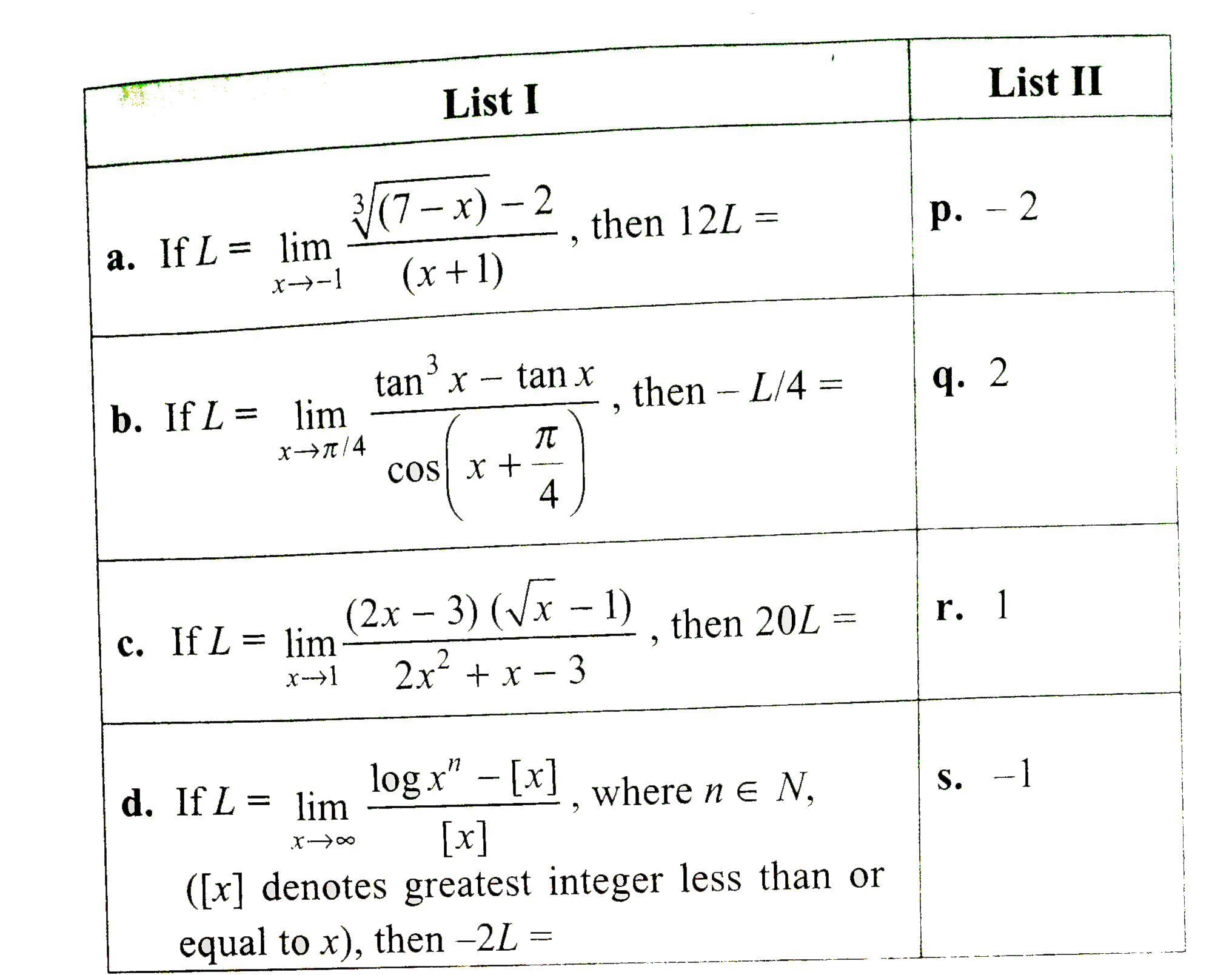If f(x)=3x2+ax+a+1x2+x−2, then which of the following can be correct (a) (lim)x→1f(x)existsa=−2 (b) (lim)x→−2f(x)existsa=13 (c) (lim)x→1f(x)=43 (d)(lim)x→−2f(x)=−13Solution in Tamil
ln a1
ean
a_(1)
an
The correct Answer is:A, B, C, D
f(x)=3x2+ax+a+1(x+2)(x−1)
As x→1,Dr→0, Hence as x→1,Nr→0. Therefore,
3+2a+1=0 or a=−2
As x→−2,Dr→0. Hence as x→−2,Nr→0. Therefore,
12−2a+a+1=0 or a=13
Now, limx→1f(x)=limx→13x2−2x−1(x+2)(x−1)=limx→1(3x+1)(x−1)(x+2)(x−1)=43
Now, limx→−23x2+13x+14(x+2)(x−1)=limx→−2(3x+7)(x+2)(x+2)(x−1)=−13
Topper's Solved these Questions
- LIMITSBOOK - CENGAGECHAPTER - LIMITSEXERCISE - Exercise (Comprehension)
20 Videos
- LIMITSBOOK - CENGAGECHAPTER - LIMITSEXERCISE - Exercise (Matrix)
5 Videos
- LIMITSBOOK - CENGAGECHAPTER - LIMITSEXERCISE - Exercise (Single)
76 Videos
- JEE 2019BOOK - CENGAGECHAPTER - JEE 2019EXERCISE - Chapter 10
9 Videos
- LINEAR COMBINATION OF VECTORS, DEPENDENT AND INDEPENDENT VECTORSBOOK - CENGAGECHAPTER - LINEAR COMBINATION OF VECTORS, DEPENDENT AND INDEPENDENT VECTORSEXERCISE - DPP 1.2
10 Videos
Similar Questions
Find the domain of f(x)=√|x|−{x} (where {⋅} denots the fractional part of x).
View SolutionMatch the following lists:

View Solution(lim)x→0[sin(sgn(x))(sgn(x))], where[.] denotes the greatest integer function, is equal to (a)0 (b) 1 (c) −1 (d) does not exist
View SolutionIf y = y(x) is the solution of the differential equation, xdydx+2y=x2 satisfying y(1) = 1, then y(12) is equal to
View SolutionThe number of integral values of p for which (p+1)ˆi−3ˆj+pˆk,pˆi+(p+1)ˆj−3ˆk and −3ˆi+pˆj+(p+1)ˆk are linearly dependent vectors is q
View SolutionIf f(x)=3x2+ax+a+1x2+x−2, then which of the following can be correct (lim)x→1f(x)eξstsa=−2 (lim)x→−2f(x)eξstsa=13 (lim)x→1f(x)=43 (lim)x→−2f(x)=−13
View SolutionIf f(x)=x(e|x|+[x]−2|x|+[x]) then (where [.] represents the greatest integer function) (lim)x→0+f(x)=−1 b. (lim)x→0−f(x)=0 c. (lim)x→0□f(x)=−1 d. (lim)x→0□f(x)=0
View SolutionIf (lim)x→2f(x−9)x−2=3 then (lim)x→2f(x), is
View Solutionif f(x)={x+2,x≤1cx2,x>−1, then find c when lim(x→−1)f(x) exists.
View SolutionThe function f(x)=p[x+1]+q[x−1] where [x] is the greatest integer function, and limx→1+f(x)=limx→1−f(x)=f(1) when-
View SolutionIf f(x)=x21+x2 then the range of f is
View SolutionGiven f(x)=⎧⎪ ⎪ ⎪ ⎪ ⎪⎨⎪ ⎪ ⎪ ⎪ ⎪⎩x|x|2x≠0x=0⎫⎪ ⎪ ⎪ ⎪ ⎪⎬⎪ ⎪ ⎪ ⎪ ⎪⎭find limx→0f(x)
View SolutionLet f(2)=4andf'(2)=4.Iflimx→2xf(2)−2f(x)x−2=−a, then a is
View SolutionIf the function f(x) satisfies (lim)x→1f(x)−2x2−1=π,evaluate (lim)x→1f(x)
View Solutionif f(x)={x+2,x≤−1cx2,x>−1, then find c when lim(x→−1)f(x) exists.
View SolutionIf f(x)=3x2+ax+a+1x2+x−2, then which of the following can be correct (lim)x→1f(x)eξstsa=−2 (lim)x→−2f(x)eξstsa=13 (lim)x→1f(x)=43 (lim)x→−2f(x)=−13
View Solution
